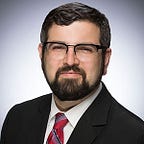We need to rethink campus policing
This is adapted from our Lumina Foundation podcast, “Today’s Students / Tomorrow’s Talent.” Click the video below to see the show, or if you’re on the go, catch us on iTunes or wherever audio podcasts are found. To see more episodes, please go to the show’s website.
What kind of presence should police have on college campuses? Our 30th episode of the Lumina Foundation podcast “Today’s Students/Tomorrow’s Talent” asks that fundamental question, and some of what we heard may surprise you.
Dr. Charles H. F. Davis III, assistant professor at the University of Michigan’s Center for the Study of Higher and Postsecondary Education, tells me and my co-host, Dr. Katherine Wheatle, that the federal government has loaned military-grade weapons to more than 100 institutions since 1990.
“There is absolutely no justification for a campus-based police department — one that is charged with creating a safe and secure learning environment — to be provided military-grade weapons,” he says.
Davis says that 90 percent of campuses have sworn officers who have the same powers as municipal police, and 75 percent carry a firearm. And while spending on campus police is rising — the University of California system spends $138 million annually — crime is trending down.
Rather than having police deal with alcohol infractions and mental-health issues, schools would be better off spending money on counseling and residence life services, he said.
And that’s what’s happening in places like Michigan State University. Marlon Lynch, vice president and chief of police at MSU, tells us that a task force on racial equity at his school led to a reorganization of police and safety functions. So when someone calls police, while they can get a response from a uniformed officer, there are now other options, including: detectives who investigate relationship violence and sexual misconduct; mental health support offering psychological services; and community engagement specialists who partner with Student Affairs.
Lynch spoke to us as part of a panel with Nadine Jones, co-founder of The Initiative Advancing the Blue and Black Partnership, whose goal is to heal the community-police relationship and build healthier communities, and Wisdom Cole, national director of the Youth & College Division at the NAACP. Cole and the NAACP are asking for accountability and transparency from the police, while Jones says that “if we can improve local relationships between civilian stakeholders and police, I think we have an opportunity to build more empathetic and healthier relationships.”
In some places, students are leading efforts to reshape policing on campus. Jael Kerandi, past student body president at the University of Minnesota, tells us how, after the murder of George Floyd by a Minneapolis police officer, she sent an open letter to the university demanding an end to its contract with the Minneapolis Police Department. “The very people you say are protecting us are the people we need protection from,” she wrote. Kerandi’s 24-hour deadline prompted a positive response from university President Joan Gabel. In an email to students, faculty, and staff, Gabel promised that the school would limit collaboration with the department and would no longer use the police for support during large campus events.
While Kerandi’s letter had the desired impact, her position drew opposition from fellow students, Minneapolis residents, and people around the nation. “There were those that were not offering anything that would serve the purpose,” Kerandi said as she reflected on the initial pushback. “While I was willing to listen to those being critical, I was not willing to listen to those being disrespectful. I told myself ‘I can take this now because 10 years ago somebody took something for me.”
Kerandi captures the key element of the movement to reshape policing on campus: This issue is multi-generational and is connected to the long fight for racial equity. She and others see their actions as part of a legacy, one that has been created by organizers, students, and leaders before them.
I think you’ll come away from the episode — as we did — feeling optimistic that conversations are taking place and that there appears to be movement in the right direction. It may not be as fast as we all would like, but it’s occurring.
And as a side note, I want to thank our listeners and followers for your continued support and interest. Thirty episodes — and three years — is a milestone we’re proud of, and we’re here because, like you, we care about building and supporting a higher education system that works for everyone.
Dakota Pawlicki leads Talent Hubs work at CivicLab. He was previously a strategy officer at Lumina Foundation leading efforts focused on community mobilization and workforce education.
